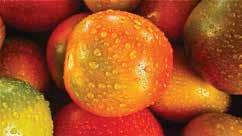conscious eating
Baby Bites
Healthy Homemade Food for Tiny Tummies by Sandra Yeyati
F Liberate yourself from suffering. Gnosis is the practical, fact-based knowledge of consciousness that guides us to our full potential and innate happiness.
Experience is better than belief. Learn more at GnosticTeachings.org
20
Grand Traverse Region
or the first year of a baby’s life, breast milk and formula are the main sources of nutrition, but as early as 4 to 6 months, a little one may be suited to try solid foods. According to the American Academy of Pediatrics, when a baby consistently holds their head up, has started to sit upright, has doubled their birth weight to a minimum of 13 pounds and exhibits an interest in food, they are ready. Anjali Shah, a board-certified health coach and author of The Super Easy Baby Food Cookbook, is a proponent of homemade purées and soft finger foods. “A store-bought sweet potato pouch can cost $2.50, whereas one sweet potato is under a dollar, and you can get multiple meals out of it,” says Shah. “So, budget-wise, it’s a lot cheaper. It’s also healthier because you can control what’s in your baby food.” The process is easy. “If you have a spoon and a fork, that’s a pretty good start, and if you have a blender, that’s really all you need,” says Amy Palanjian, author of Busy Little Hands: Food Play! and blogger at YummyToddlerFood.com. A very basic technique, which both she and Shah employ, involves boiling or steaming vegetables and fruits, puréeing them with a fork or blender to the desired smoothness and freezing one-ounce portions in ice cube trays. Once frozen, the cubes can be popped out, kept in labeled freezer bags and thawed to serve. They recommend a progression from thin, smooth purées to chunkier blends, and from very mild, single foods to progressively more adventuresome and complex flavors and textures. “Start with a really mild fruit like avocado or a really mild vegetable like carrots, green beans or sweet potato,” Shah advises. “Introduce one food every two or three days to make sure your baby is not allergic and that it suits their digestive system.” In addition to purées, parents can offer their babies small-cut, softened versions of foods that they can hold in their hands and gnaw, a technique called baby-led weaning. “Your baby will pick it up with their fists, stick it in their mouth and drool all over it and gum it up. It teaches them to chew very early on,” Shah explains. “Kids need healthy fats for proper brain development,” Palanjian says, suggesting a splash of olive oil in a broccoli purée or a dab of peanut butter in oatmeal. She also favors healthy proteins like a purée made with hard-boiled egg yolk slathered on a piece of toast or a well-blended bit of salmon. “At 7 or 8 months, you can add lentils, beans and grains, and around 9 or 10 months you can start introducing mild spices—cinnamon, cardamom, nutmeg, turmeric, cumin,
HealthyLivingMichigan.com






